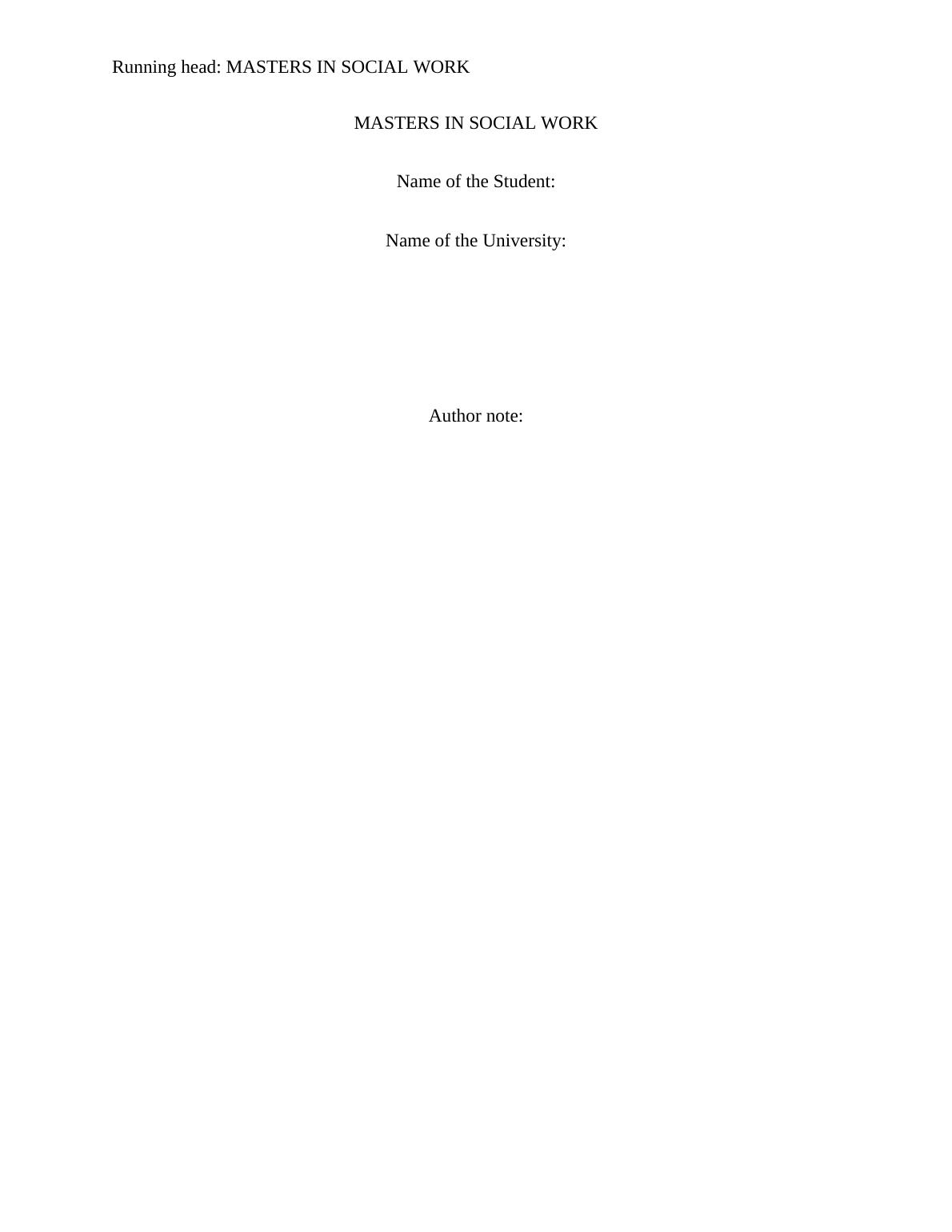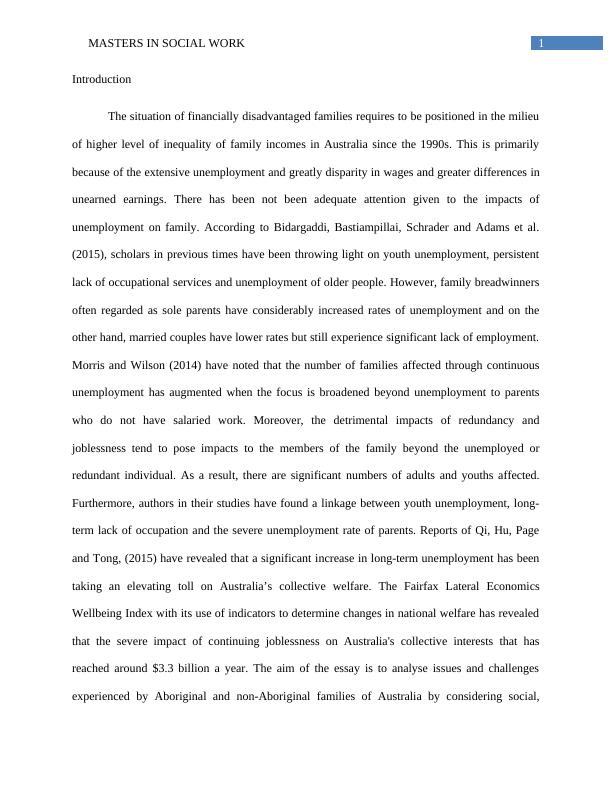Challenges of Unemployment in Australian Families
Added on 2022-12-27
16 Pages4115 Words44 Views
Running head: MASTERS IN SOCIAL WORK
MASTERS IN SOCIAL WORK
Name of the Student:
Name of the University:
Author note:
MASTERS IN SOCIAL WORK
Name of the Student:
Name of the University:
Author note:

1MASTERS IN SOCIAL WORK
Introduction
The situation of financially disadvantaged families requires to be positioned in the milieu
of higher level of inequality of family incomes in Australia since the 1990s. This is primarily
because of the extensive unemployment and greatly disparity in wages and greater differences in
unearned earnings. There has been not been adequate attention given to the impacts of
unemployment on family. According to Bidargaddi, Bastiampillai, Schrader and Adams et al.
(2015), scholars in previous times have been throwing light on youth unemployment, persistent
lack of occupational services and unemployment of older people. However, family breadwinners
often regarded as sole parents have considerably increased rates of unemployment and on the
other hand, married couples have lower rates but still experience significant lack of employment.
Morris and Wilson (2014) have noted that the number of families affected through continuous
unemployment has augmented when the focus is broadened beyond unemployment to parents
who do not have salaried work. Moreover, the detrimental impacts of redundancy and
joblessness tend to pose impacts to the members of the family beyond the unemployed or
redundant individual. As a result, there are significant numbers of adults and youths affected.
Furthermore, authors in their studies have found a linkage between youth unemployment, long-
term lack of occupation and the severe unemployment rate of parents. Reports of Qi, Hu, Page
and Tong, (2015) have revealed that a significant increase in long-term unemployment has been
taking an elevating toll on Australia’s collective welfare. The Fairfax Lateral Economics
Wellbeing Index with its use of indicators to determine changes in national welfare has revealed
that the severe impact of continuing joblessness on Australia's collective interests that has
reached around $3.3 billion a year. The aim of the essay is to analyse issues and challenges
experienced by Aboriginal and non-Aboriginal families of Australia by considering social,
Introduction
The situation of financially disadvantaged families requires to be positioned in the milieu
of higher level of inequality of family incomes in Australia since the 1990s. This is primarily
because of the extensive unemployment and greatly disparity in wages and greater differences in
unearned earnings. There has been not been adequate attention given to the impacts of
unemployment on family. According to Bidargaddi, Bastiampillai, Schrader and Adams et al.
(2015), scholars in previous times have been throwing light on youth unemployment, persistent
lack of occupational services and unemployment of older people. However, family breadwinners
often regarded as sole parents have considerably increased rates of unemployment and on the
other hand, married couples have lower rates but still experience significant lack of employment.
Morris and Wilson (2014) have noted that the number of families affected through continuous
unemployment has augmented when the focus is broadened beyond unemployment to parents
who do not have salaried work. Moreover, the detrimental impacts of redundancy and
joblessness tend to pose impacts to the members of the family beyond the unemployed or
redundant individual. As a result, there are significant numbers of adults and youths affected.
Furthermore, authors in their studies have found a linkage between youth unemployment, long-
term lack of occupation and the severe unemployment rate of parents. Reports of Qi, Hu, Page
and Tong, (2015) have revealed that a significant increase in long-term unemployment has been
taking an elevating toll on Australia’s collective welfare. The Fairfax Lateral Economics
Wellbeing Index with its use of indicators to determine changes in national welfare has revealed
that the severe impact of continuing joblessness on Australia's collective interests that has
reached around $3.3 billion a year. The aim of the essay is to analyse issues and challenges
experienced by Aboriginal and non-Aboriginal families of Australia by considering social,

2MASTERS IN SOCIAL WORK
political and social consequences of unemployment. In addition to this the essay will focus on
the theoretical and ethical frameworks which will aid social workers to successfully navigate
these challenges.
Discussion
Reflecting on the Australian development, there can be witnessed increasing numbers of
families without any sole earning members or parents being employed and on the other hand
more families with both parents engaged in the workforce. According to Biddle and Hunter
(2018), there has been witnessed diminutive movement out of unemployment in support of the
families and low-income families who showed propensity of losing salaried work rather than
gaining it. As family welfare has developed to be increasingly dependent on women's income,
the reduced competence of families with an unemployed male breadwinner to be able to take
benefit of this has been identified as a subject of significant concern. Furthermore,
comprehensive studies of Waterworth, Rosenberg, Braham & Pescud (2014) have noted that
several families comprising of older children and an unemployed or low-paid breadwinner tend
to face additional financial pressure along with family conflict due to the monetary dependence
of teenage and young adult offspring or being still redundant resulting to excessively
concentrated in the midst of vulnerable families. Furthermore, it has been noted that the impact
on families has worsen due to the elevated challenges experienced by youths in Australia in
getting hold of inexpensive accommodation and due to an augmentation in the proportion of
young adults who are staying with family home. Moreover, in other Australian families, the
damage of low family earnings and drawn out teenage dependency has severely resulted to youth
homelessness. According to government reports, official estimates of unemployment tend to
understate the degree of lack of salaried work in families. It has been noted that some family
political and social consequences of unemployment. In addition to this the essay will focus on
the theoretical and ethical frameworks which will aid social workers to successfully navigate
these challenges.
Discussion
Reflecting on the Australian development, there can be witnessed increasing numbers of
families without any sole earning members or parents being employed and on the other hand
more families with both parents engaged in the workforce. According to Biddle and Hunter
(2018), there has been witnessed diminutive movement out of unemployment in support of the
families and low-income families who showed propensity of losing salaried work rather than
gaining it. As family welfare has developed to be increasingly dependent on women's income,
the reduced competence of families with an unemployed male breadwinner to be able to take
benefit of this has been identified as a subject of significant concern. Furthermore,
comprehensive studies of Waterworth, Rosenberg, Braham & Pescud (2014) have noted that
several families comprising of older children and an unemployed or low-paid breadwinner tend
to face additional financial pressure along with family conflict due to the monetary dependence
of teenage and young adult offspring or being still redundant resulting to excessively
concentrated in the midst of vulnerable families. Furthermore, it has been noted that the impact
on families has worsen due to the elevated challenges experienced by youths in Australia in
getting hold of inexpensive accommodation and due to an augmentation in the proportion of
young adults who are staying with family home. Moreover, in other Australian families, the
damage of low family earnings and drawn out teenage dependency has severely resulted to youth
homelessness. According to government reports, official estimates of unemployment tend to
understate the degree of lack of salaried work in families. It has been noted that some family

3MASTERS IN SOCIAL WORK
members a number of family members specifically wives, women single parents and older men
show a tendency of withdraw from current job search during times of unemployment. As a
result, they have greater propensity to be vulnerable to joblessness (Aifs.gov.au 2019). Recent
reports have noted that in 2014, the Australian Bureau of Statistics (ABS) accounted over 3
million Australians aged 18 years to 65 years to be unemployed. Authors have witnessed a strong
linkage between unemployment and joblessness in Australian families. According to author,
2011, around 731,200 families comprising one or more unemployed member (12.5% of all
families) and these families comprising at least one unemployed member did not comprise of any
family member in salaried work (Aifs.gov.au 2019). Furthermore, while comparing with other
nations, Australia show considerably high association between unemployment and joblessness in
families.
On the other hand, one of the critical ways in which Aboriginal and Torres Strait Islander
Australians have been encountering challenges is through disparity of earnings. Daly (2018) has
noted that lack of occupational opportunities and low earnings are connected extensive array of
disadvantages that includes poor health, brief life expectancy, underprivileged education,
substance abuse, reduced level of social participation in addition to crime and violence.
However, job seekers often face many barriers in pursuing employment, including living with a
physical or mental illness or disability, or having caring responsibilities. Indigenous Australians
have, on average, lower employment rates than non-Indigenous Australians for a range of
reasons. These include lower levels of education and training, living in areas with fewer
employment opportunities, higher levels of contact with the criminal justice system, experiences
of discrimination, and lower levels of job retention . As per reports, between 2010 and 2015, the
overall Aboriginal unemployment rate has remained at around 25% or above. While, in 2015 it
members a number of family members specifically wives, women single parents and older men
show a tendency of withdraw from current job search during times of unemployment. As a
result, they have greater propensity to be vulnerable to joblessness (Aifs.gov.au 2019). Recent
reports have noted that in 2014, the Australian Bureau of Statistics (ABS) accounted over 3
million Australians aged 18 years to 65 years to be unemployed. Authors have witnessed a strong
linkage between unemployment and joblessness in Australian families. According to author,
2011, around 731,200 families comprising one or more unemployed member (12.5% of all
families) and these families comprising at least one unemployed member did not comprise of any
family member in salaried work (Aifs.gov.au 2019). Furthermore, while comparing with other
nations, Australia show considerably high association between unemployment and joblessness in
families.
On the other hand, one of the critical ways in which Aboriginal and Torres Strait Islander
Australians have been encountering challenges is through disparity of earnings. Daly (2018) has
noted that lack of occupational opportunities and low earnings are connected extensive array of
disadvantages that includes poor health, brief life expectancy, underprivileged education,
substance abuse, reduced level of social participation in addition to crime and violence.
However, job seekers often face many barriers in pursuing employment, including living with a
physical or mental illness or disability, or having caring responsibilities. Indigenous Australians
have, on average, lower employment rates than non-Indigenous Australians for a range of
reasons. These include lower levels of education and training, living in areas with fewer
employment opportunities, higher levels of contact with the criminal justice system, experiences
of discrimination, and lower levels of job retention . As per reports, between 2010 and 2015, the
overall Aboriginal unemployment rate has remained at around 25% or above. While, in 2015 it

End of preview
Want to access all the pages? Upload your documents or become a member.
Related Documents
SOCIAL DISADVANTAGES IN AUSTRALIA POST.lg...
|4
|487
|94
3936NRS Child and Youth Mental Healthlg...
|5
|1136
|36
Assignment on Sociology Change Proposallg...
|5
|1681
|10
Social Work Research Paper 2022lg...
|7
|1653
|8
Poverty and Homelessness Assignmentlg...
|3
|947
|44
Intergenerational Trauma Assignment Reportlg...
|7
|2089
|12
